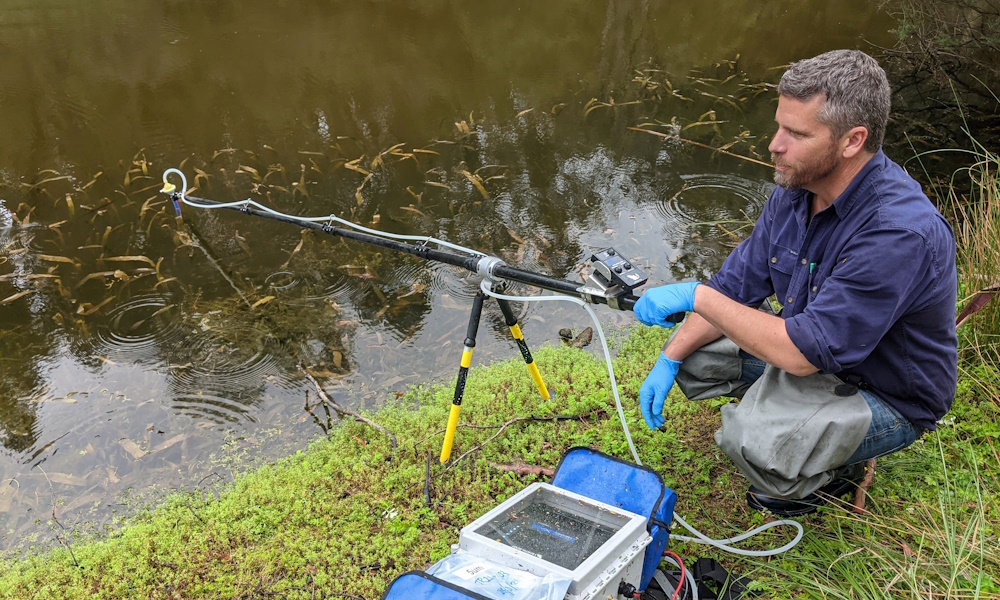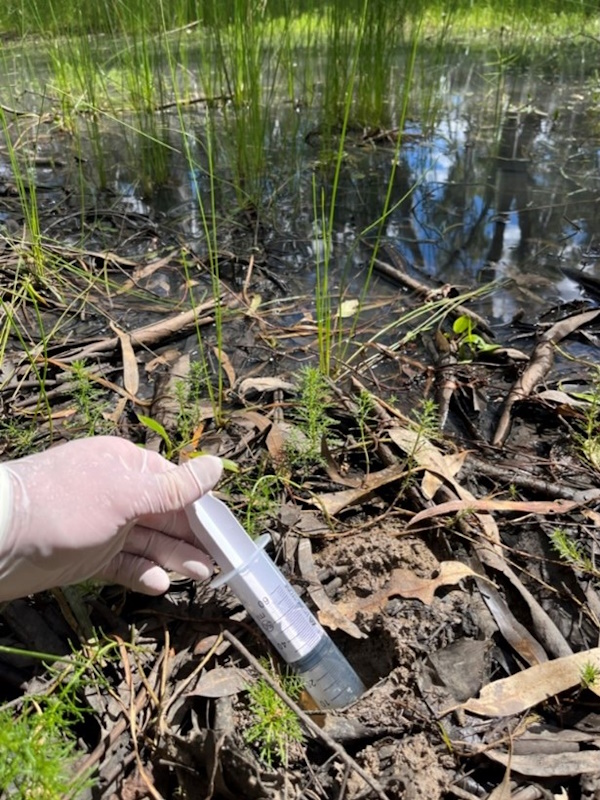In short
|

Collecting an eDNA sample from a river.
eDNA in monitoring and research
Environmental DNA (eDNA) is a modern tool for detecting plants and animals by collecting traces of their genetic material from water, soil, or air. These traces—such as skin cells, waste, or pollen—allow researchers to confirm species presence without capturing or observing them directly.
Waterways are especially useful for eDNA sampling, as DNA moves with water flows, enabling large‑area surveys from a single site.
Although eDNA is still a new tool in science, it is rapidly gaining popularity in research and monitoring. It can complement or even replace traditional survey methods, often at lower cost and across wider areas. However, it's suitability for research and monitoring depends on the species and environment being studied.
eDNA offers the potential to detect:
- species that are difficult, time-consuming or expensive to find; including species that are cryptic, rare, microscopic, nocturnal or found in hard-to-survey areas.
- multiple species from a single sample using a technique called metabarcoding
- early incursions of pest species or diseases to inform rapid management responses.
What we are doing
Since 2018, ARI has worked with eDNA in many environmental research contexts including:
- Detecting rare and pest species – using eDNA to find threatened fish, mussels, amphibians, spotted-tail quolls and invasive species (for example deer and willow).
- Designing survey methods – creating reliable eDNA study designs.
- Reviewing data – checking large eDNA datasets for accuracy, including spotting false positives and negatives.
- Studying uncertainty – reviewing research on the limits of eDNA, especially for freshwater species.
- Improving techniques – developing better ways to collect and analyse eDNA, including tests for new species in Victoria.
- Rapid in-field testing – creating eDNA tests that give quick results in the field using new technology.
- Validation studies – comparing eDNA results with traditional survey methods.
- Exploring new uses – trialling detection of aquatic plants with eDNA.
Research examples
ARI completed a preliminary study to determine the effectiveness of eDNA survey methods for monitoring aquatic and semi-aquatic plants. The study developed eDNA references for 22 plant species; 15 of which could be identified to species level and 7 to genus. eDNA references for an additional 3 species were not successful.
The study found 81 separate plant taxa detected in the water samples. Of these, 36 plant species from 17 families could be identified to species level. True positive records were reliably recorded when the species is in close proximity to the sample site. To avoid false positive samples in flowing systems, sampling may need to be very close to the plant locations to ensure detection using the approach applied in this study.
In wetlands, higher turbidity blocked sampling filters more quickly. Although all target species were detected in the current study, filtering smaller volumes increases the risk of some species going undetected.
Publications
ARI trailed the use of eDNA soil analysis as a survey method for detecting spotted-tailed quolls. We developed a species-specific assay and collected environment soil samples from the Snowy River region at communal quoll defecation sites (latrines) and from broader quoll habitat.
Sensitivity was highest at latrine sites, but decreased sharply when sampling just 1 m away. Given that quoll latrines can usually be identified from the accumulation of scats, eDNA analysis of soil is unlikely to improve surveys over current spotted-tailed quoll monitoring methods.
Publications:
- White et. al (2024) Environmental DNA detection of spot-tailed quoll from soil is unlikely to be useful for routine monitoring. Wildlife Research.

Spotted-tailed Quoll - photo by Andrew Geschke
ARI investigated the use of eDNA sampling as a monitoring tool after eradication for early detection of deer reinvasion. We successfully detected both Sambar and Hog deer from water samples, however a rigorous collection method was required – five samples per site, an average sample volume of 250 mL of water, three PCR replicates. With this method the sensitivity of the survey was 30-60% for sambar deer and 75-85% for hog deer.
The combination of a very small Sambar Deer population size and the relatively fast flowing waterway appears to limit the detectability of deer in water samples in our study. Detection of deer will depend on the:
- interaction of the rainfall in the days preceding sample collection,
- water flow rates,
- here samples are collected (e.g. edge of the stream or further from the bank)
- volume of water sampled
- expertise of the sample collection team.

Sambar Deer - photo by Justin Cally
Limitations of eDNA
Environmental DNA (eDNA) is a promising but still developing tool. Many projects now use eDNA surveys alongside traditional methods like capture or observation, yet challenges remain in how results are interpreted.
Uncertainties still exist in its use for detecting species’ presence, which may limit its value in some cases. Furthermore, eDNA technology cannot yet be used to reliably measure the relative abundance or demography of species at sites, meaning that it is inappropriate to use in many research and monitoring contexts.
eDNA is only as reliable as the methods used to collect and analyse it. Combining eDNA with traditional survey methods can aid the interpretation of eDNA results. To get accurate results, we need consistent field and lab protocols. Implementation of survey standards will improve data quality, reduce errors, and build confidence in eDNA findings.
There are many current gaps in knowledge regarding:
- how biological and physical factors affect detection probabilities
- how survey effectiveness is influenced by species’ characteristics
- best practices for survey design, quality control and assurance measures.

Using a syringe to collect an eDNA sample from a crayfish burrow.
How we can help
ARI offers expert support to guide the effective and appropriate use of eDNA in research and monitoring across Victoria. Our services include:
- Project guidance – expert advice on how to best use eDNA to meet your project goals.
- Data review – assessing and interpreting existing eDNA datasets to ensure accurate and meaningful results.
- Project integration – identifying how eDNA can be incorporated into new or existing monitoring and research programs.
- Filling knowledge gaps – delivering targeted research to improve confidence in eDNA methods and results.
- Technique development – developing and refining methods for collecting and analysing eDNA samples.
- Custom assay design – creating eDNA tests for species that are yet to be studied using eDNA methods.

Taking eDNA water sample with filter - photo by Tarmo Raadik.
More information
For further information about ARI’s eDNA expertise contact research.ari@deeca.vic.gov.au
Page last updated: 19/11/25